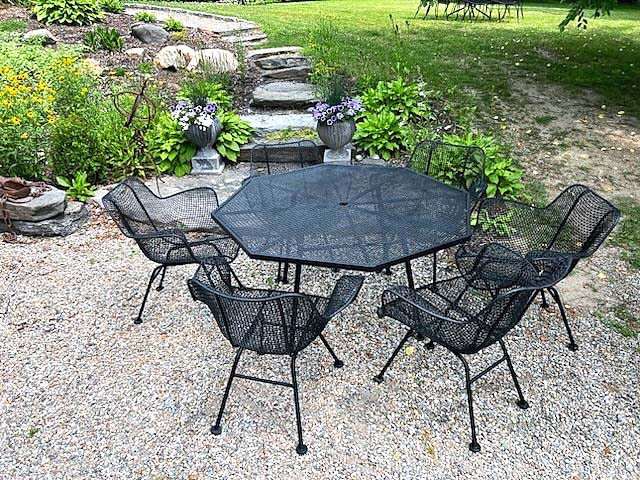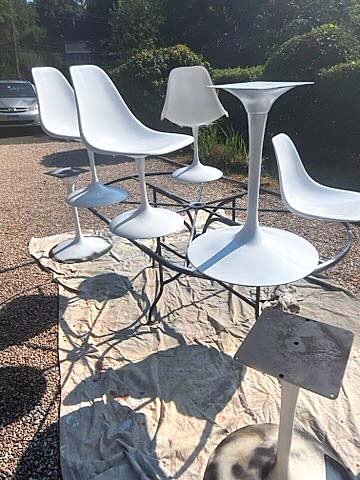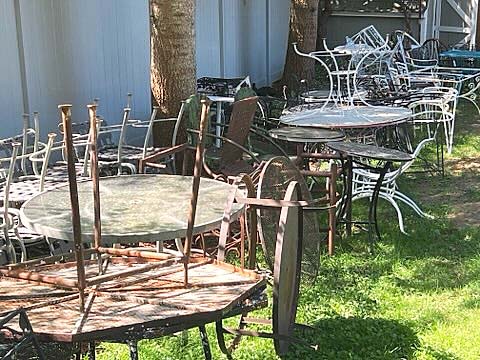
After receiving a liberal arts degree at DePauw University in 1974, JEF (his initials) from Ridgefield, Conn., earned an MBA at the Kellogg School of Management at Northwestern University. With a major in marketing, he accepted his first job in product management at Carnation Company. It didn’t take long to discover his desire to be closer to the creative process. As VP Account Management at major Madison Avenue agencies Benton & Bowles and Young & Rubicam he got very close. But it wasn’t until he opened his own agency, JFC Group, that he would enjoy total control of the creative process…art direction and copywriting. He employs these skills, primarily on Facebook Marketplace and other Ridgefield-oriented groups, to sell upscale outdoor cast iron patio sets that he restores and the occasional Midcentury Modern piece of furniture.
How did you get started collecting and restoring antique and vintage outdoor sets?
I’ve been collecting my entire life. It sounds funny to say, but I like “stuff,” and once you have two of anything you’ve started a collection. The bigger the better, right? So as a little kid in the ‘50s I started with rocks, mostly quartz. I’d bust them open with a hammer or another bigger rock. Chips and fragments flying everywhere, with no protective eyewear! Those were the days. I also had a huge collection of Army men I’d play with for hours. The rocks are history, but I still have “my men”…naturally.
Fast forward about 20 years, I had just graduated college and was in need of inexpensive furniture for my small NYC apartment (that’s when they were still affordable). It was at my first hometown garage sale where I discovered a 1930s secretary desk in need of some TLC. That was my first antique restoration project. Upon revealing the beautiful walnut veneer hiding under multiple layers of paint, I was hooked. So gratifying. The rest is history. I fell in love with both the hunt and restoration of antique furniture. Naturally, a lot of buying results in a lot of selling, which I’ve grown to enjoy just as much. It’s a social thing…meeting kindred spirits who share the passion.
As I’ve gotten older, I’ve found the process to get a bit more tedious and difficult. Restoring wood furniture, in particular large pieces, is time-consuming and must be done indoors. Burn out was setting in, but I needed my projects! Vintage midcentury wrought iron patio sets was the answer.

A fully restored 1960s wrought iron Russell Woodard Sculptura dining set.
What was the appeal of outdoor furniture?
Not just any outdoor furniture. It had to be of top quality and affordable for me to turn a profit. Vintage, post-World War II “stuff” fit the bill. As a former Madison Avenue ad guy, I understood the new popularity of Midcentury Modern furniture. In fact, I had already transitioned to restoring and selling a lot of it. But as I said, I was tiring of wood projects when I had a big idea. Why can’t the appeal of quality MCM furniture be expanded to include outdoor? That wrought iron “stuff” I grew up with is more than 60 years old and it’s indestructible…made of quality US steel. In fact, it’s on my deck right now.
So that was it. The “stuff” I had been ignoring at all the garage and estate sales I visited over the years, had tremendous sales potential. There’s still a lot around, and much of it is rusty and unappealing. Perfect! One other important thing, though. Most of the young people who are buying now, either don’t know how or have no interest in restoration. Bingo: Leave it to me.
What’s involved in tuning up a typical patio set that’s seen significant outdoor use?
That’s the beauty of it. It’s really not that difficult or time-consuming if you have the right tools. I make a point of buying structurally solid pieces so welding is avoided. Although I do have a spot welder on the rare occasions it’s necessary. I’m still learning.
So I start with power washing using the most intense pressure attachment. This removes nearly all loose paint. Then a stiff wire brush to finish up and prep any rust for a rust converter that follows. An either spray or brush-on application will turn the rust into a durable, non-rusting surface that can be painted. I use a compresson-powered sprayer to apply a couple coats of oil-based Rust-Oleum. And that’s it. I’m often asked if I sand blast down to the bare metal. I don’t. It’s costly and I actually don’t find the end result appealing. It looks too perfect, brand new, and loses its vintage-look appeal…at least to my eye.

Midcentury Modern Euro Saarinen-style tulip tables being restored.
Which brands or manufacturers constitute desirable garden furniture as opposed to the knockoff sets made in China?
Good question. I’m really no expert on this subject. I’m sure China produces some good outdoor furniture, but I think it’s generally understood that today’s metal and the alloys that go into it are inferior to the “good stuff” of the past. The two vintage manufacturers that have risen to the top based on my experience are Russell Woodard (still in business today) and Salterini.
Why do you choose Facebook Marketplace as a marketing platform to sell?
I find Facebook Marketplace to be a very effective medium to reach the local audience I seek. It’s easy to use and it’s free. That’s great. It also appeals to a large audience that values being able to view the profile of the person they might be buying from. That benefit works for the seller as well. Unfortunately, I’ve begun to experience a significant increase in scammers recently.
Some of your descriptions sound like something out of a J. Peterman catalog. Where did you acquire your copywriting skills?
Thanks for the compliment. I don’t know. I’ve always enjoyed writing. The idea of creating something that captures a thought or an emotion that can be shared with others. I’m an avid photographer as well. They’re similar that way. A career in a couple ad agencies on Madison Avenue may have played a role as well.
You also offer Midcentury Modern pieces in your Facebook posts. What do you find compelling about this category of furniture?
When you live long enough, your tastes change, I guess. For years when I was on the hunt for antiques, I’d walk right past that “stuff” I grew up with. Nothing special or unique for that reason. But with age, wisdom and an eye toward design trends, my appreciation for “the good stuff” from the ‘50s and ‘60s evolved. It had become valuable, collectible and sought-after. The good pieces have designer names associated with them like Eames, Saarinen and Bertoia; adding to their perceived value. Yes, the design is very appealing to me, but I think the challenge of finding it is a lot of fun as well. It’s competition to me. There’s money to be made if you can find it at the right price.
How do you store what would appear to be a large collection?
The beauty of wrought iron is that it can be stored outdoors. Fortunately, I have enough property, but I must admit my family is becoming increasingly aggravated, by what my daughter calls my “hoard.” I assure her that my enthusiasm and energy is starting to wane, and my inventory will soon follow.

Stacked inventory waiting for their turn for spring 2024.
Would you consider showing at some East Coast show venues, such as Brimfield, Deerfield and the like?
Nope. That sounds like too much work. I find the social aspect kind of appealing, but I’m not up for all the work associated with shows…especially given the size and weight of my “stuff.” I prefer selling to the people who are selling at the shows, and I’ve done a fair amount of that.
Are you a solo act or are there some family members that assist you?
I couldn’t do what I do without the patience and help of my wife, Mary. I do the buying, selling and restoration. But she’s indispensable when it comes to the lifting and moving. With a ton of furniture sitting on the grass in my backyard, it’s got to be moved periodically so I can mow the lawn. She’s become an expert at it!
Any predictions on what the next hot category in furniture will be after MCM loses its luster?
That’s a hard one. I think it’s here to stay for a long time. The digital world we live in aligns perfectly with the clean, simple design and functionality that MCM furniture offers. I like to say the young people buying furniture these days have an Apple Store mentality when it comes to interior design.
Unfortunately, all the “stuff” we boomers and our parents collected and proudly displayed in china cabinets no longer has a home. I guess less is more when it comes to collecting “stuff” these days!
—W.A. Demers




